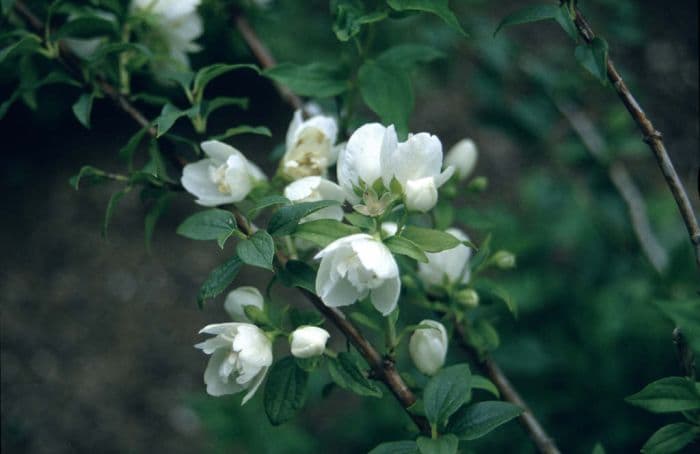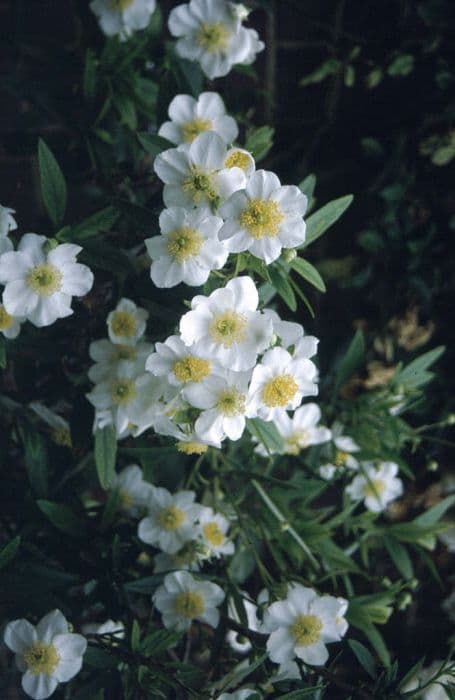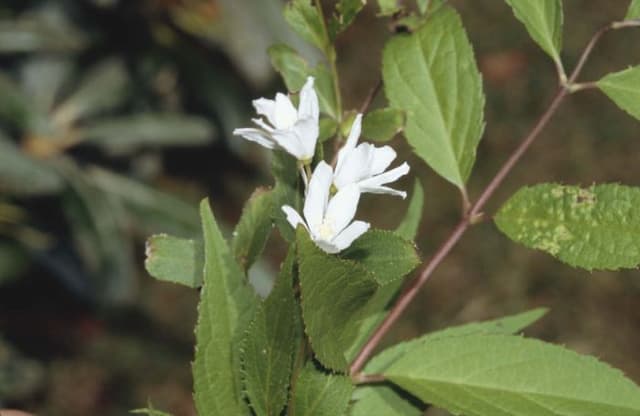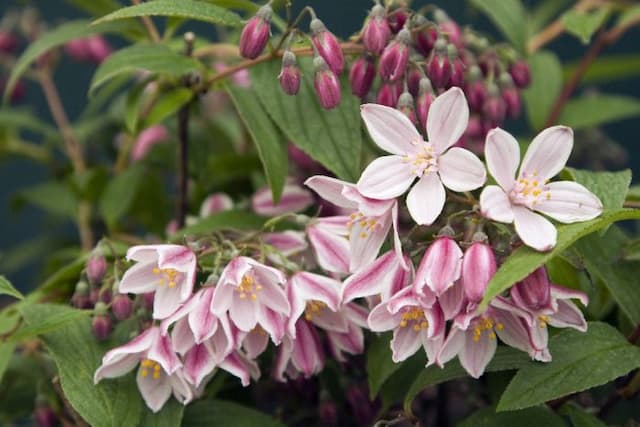Mock Orange Philadelphus 'Manteau d'Hermine' (d)

ABOUT
Philadelphus 'Manteau d'Hermine', commonly known as mock orange, is a deciduous shrub known for its profuse display of fragrant flowers. The plant has a bushy, rounded shape and is adorned with medium green leaves. The leaves are simple in form, coming to a point at the tip, and have a slightly toothed edge. This mock orange is celebrated for its abundant white flowers that appear in the late spring to early summer. The flowers are double, meaning they have extra petals, and resemble small roses. They cluster at the ends of the branches, creating a snowball effect that contrasts beautifully with the green foliage. The blossoms emit a sweet, citrus-like fragrance that can fill a garden space, attracting pollinators and making it a favorite for sensory gardens. The overall appearance of Philadelphus 'Manteau d'Hermine' is one of a lush, flower-covered shrub that brings both visual interest and a delightful scent to the landscape during its blooming season.
About this plant
 Names
NamesSynonyms
Mock Orange, Sweet Mock Orange, English Dogwood
Common names
Philadelphus 'Manteau d'Hermine'
 Toxicity
ToxicityTo humans
Mock orange, scientifically known as Philadelphus 'Manteau d'Hermine', is generally considered non-toxic to humans. There are no well-documented cases or reports of poisoning from ingestion of parts of this plant. Therefore, there are no specific symptoms associated with mock orange poisoning in humans, as it is typically not hazardous when touched or ingested in small quantities.
To pets
Mock orange, scientifically known as Philadelphus 'Manteau d'Hermine', is not known to be toxic to pets such as cats and dogs. It is considered non-toxic and there have been no significant reports of illness related to pets ingesting this plant. Consequently, there are no specific symptoms of poisoning or toxicity recognized regarding mock orange for household pets.
 Characteristics
CharacteristicsLife cycle
Perennials
Foliage type
Deciduous
Color of leaves
Green
Flower color
White
Height
3 feet (0.91 meters)
Spread
4 feet (1.22 meters)
Plant type
Shrub
Hardiness zones
5
Native area
Southeast Europe Western Asia
Benefits
 General Benefits
General Benefits- Attractive Fragrance: The Sweet Mock Orange is renowned for its delightful scent, which can enhance the sensory appeal of any garden.
- Ornamental Flowers: It produces abundant white flowers that provide a decorative element to landscapes.
- Low Maintenance: This shrub is relatively easy to care for, requiring minimal upkeep to thrive.
- Drought Tolerant: Once established, it has good drought resistance, making it suitable for gardens in drier climates.
- Pollinator-Friendly: The flowers attract bees and other pollinators, supporting local ecosystems.
- Habitat Plant: It provides shelter and food for wildlife, such as birds that might feed on the seeds or use the bush for nesting.
- Privacy Screen: When planted in groups, the Sweet Mock Orange can form a dense hedge, offering privacy and reducing noise pollution.
- Seasonal Interest: It has a season of interest in late spring to early summer when it is in bloom, providing a visual highlight in the garden.
 Medical Properties
Medical PropertiesThis plant is not used for medical purposes.
 Air-purifying Qualities
Air-purifying QualitiesThis plant is not specifically known for air purifying qualities.
 Other Uses
Other Uses- Crafting Natural Dyes: The blossoms of Mock Orange can be used to create natural dyes for fabrics, offering hues from gentle yellows to greens depending on the mordant used.
- Photography Prop: The abundant white flowers of Mock Orange can serve as an elegant backdrop or a subject in botanical photography, adding aesthetic value to the composition.
- Educational Tool: The plant can be used to teach botany students about shrub morphology and the characteristics of the Hydrangeaceae family.
- Floral Arrangements: Mock Orange branches can be cut and included in floral arrangements for their fragrant blooms, adding texture and a pleasant aroma.
- Garden Design: Mock Orange can be used as a focal point in a sensory garden due to its strong fragrance, especially pleasant during the evening.
- Landscape Painting: Artists can use Mock Orange's flowering period as inspiration for landscape paintings, capturing the essence of spring or early summer.
- Fragrance Extraction: Although not commonly done, the petals of Mock Orange could potentially be used in creating essential oils or perfumes for their sweet scent.
- Insect Habitat: The dense foliage of Mock Orange provides shelter for beneficial insects and can be included in gardens aiming to promote biodiversity.
- Soil Erosion Control: With its robust root system, Mock Orange can be planted on slopes or areas prone to erosion to help stabilize the soil.
- Holiday Decor: During its off-season, the woody stems and seed heads of Mock Orange can be collected and used for creating rustic fall or winter decorations.
Interesting Facts
 Feng Shui
Feng ShuiMock Orange is not used in Feng Shui practice.
 Zodiac Sign Compitability
Zodiac Sign CompitabilityMock Orange is not used in astrology practice.
 Plant Symbolism
Plant Symbolism- Innocence: The Philadelphus 'Manteau d'Hermine', commonly known as the Mock Orange, often symbolizes purity and innocence due to its pristine white flowers, reminiscent of the simplicity and untouched beauty of nature.
- Purity: The clean and fresh fragrance of Mock Orange blossoms is associated with the concept of purity, suggesting a fresh start or a clear conscience.
- Rebirth: Blooming in the late spring or early summer, the Mock Orange's lifecycle is often seen as a symbol of renewal and rebirth, as it bursts forth with vitality after the dormancy of winter.
- Brotherly love: The genus name 'Philadelphus' is derived from Greek words "philos," meaning loving, and "adelphos," meaning brother, which translates to brotherly love, often symbolizing the bond and affection found in platonic relationships.
 Water
WaterThe Mock Orange 'Manteau d'Hermine' prefers consistently moist soil, particularly during its first growing season. It should be watered deeply once a week, providing about one to one and a half gallons of water each time. During hot and dry periods, increase the frequency to twice a week. It's important not to let the soil dry out completely but also to avoid waterlogging as this can lead to root rot. As the plant establishes, it becomes somewhat drought-tolerant and may require less frequent watering.
 Light
LightThe Mock Orange 'Manteau d'Hermine' thrives in full sun to partial shade. It performs best in a location where it receives at least four to six hours of direct sunlight each day. However, in regions with very hot summers, it benefits from some afternoon shade to protect it from intense heat.
 Temperature
TemperatureThe Mock Orange 'Manteau d'Hermine' is hardy and can withstand a wide temperature range. It can survive in temperatures as low as -20°F and as high as 100°F. Ideally, it grows best in a climate where daytime temperatures are between 60°F and 80°F.
 Pruning
PruningThe Mock Orange 'Manteau d'Hermine' should be pruned to maintain its shape and remove any dead or damaged wood. Pruning is best done immediately after flowering has finished, as the plant blooms on old wood. Annually removing some of the older stems encourages healthy new growth and better bloom production for the following season.
 Cleaning
CleaningAs needed
 Soil
SoilMock Orange 'Manteau d'Hermine' thrives in well-drained soil enriched with compost, with a pH of 6.0 to 7.5, leaning towards slightly acidic to neutral.
 Repotting
RepottingMock Orange 'Manteau d'Hermine' doesn't typically require repotting as it is usually grown outdoor; however, it may need transplanting every few years if grown in a container.
 Humidity & Misting
Humidity & MistingMock Orange 'Manteau d'Hermine' is adaptable to a range of humidity levels and does not require any special humidity considerations.
 Suitable locations
Suitable locationsIndoor
Ensure bright light, cool temps, and well-draining soil.
Outdoor
Plant in sun to partial shade, water regularly.
Hardiness zone
4-8 USDA
 Life cycle
Life cyclePhiladelphus 'Manteau d'Hermine', commonly known as mock orange, begins its life as a seed, which will germinate when the conditions are ideal—usually in the spring following a period of stratification that breaks seed dormancy. The seedling emerges and establishes itself, growing into a small shrub with a woody stem over the course of several years. The shrub reaches maturity and starts to flower, typically in late spring to early summer, showcasing fragrant white blossoms that attract pollinators. After pollination, the flowers develop into small, hard capsules that contain numerous seeds; these seeds are dispersed by wind or animals later in the season. The shrub enters a period of dormancy during the colder autumn and winter months, where growth slows or stops and the plant conserves energy. The mock orange can live for many years, repeating this cycle annually and can spread through suckering to form colonies if not pruned and managed.
 Propogation
PropogationPropogation time
Spring to Summer
Propogation: The most popular method of propagating the Mock Orange 'Manteau d'Hermine' is through softwood cuttings, which is typically done in late spring to early summer. To propagate, select healthy, new growth that is about 4 to 6 inches long and cut just below a node. Remove the lower leaves and dip the cut end in a rooting hormone powder to encourage root development. The cutting should then be placed in a well-draining potting mix, ensuring at least one node is below the surface. Maintain consistent moisture and provide a warm environment with indirect light until roots have formed, which usually takes a few weeks. After rooting, cuttings can be gradually acclimated to outdoor conditions before planting in their final location.







![Hydrangea [Strong Annabelle]](/_next/image?url=https%3A%2F%2Fplants-admin.emdemapps.com%2Fimages%2Fplants%2F%2Fimages%2F604b54db37d34.png&w=640&q=75)

